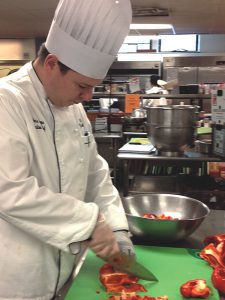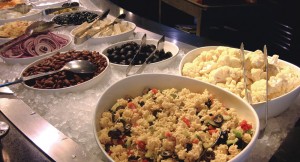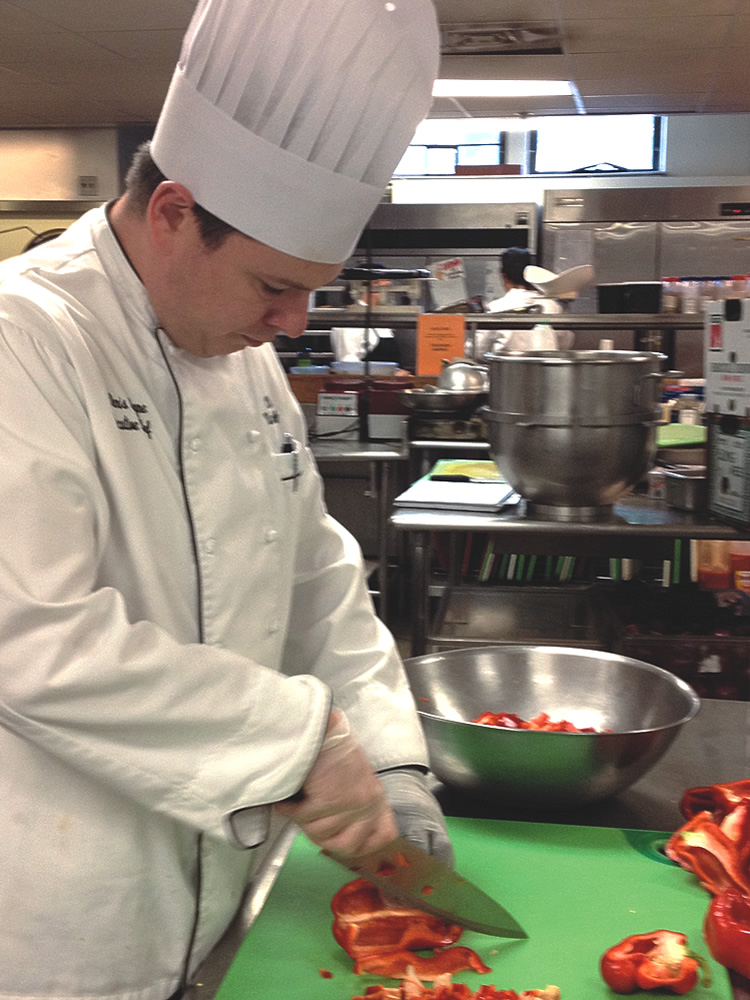Improved trimming skills, dating items to ensure the oldest is used first and daily fresh deliveries are among source reduction steps used by grocers and food service companies.
Sarah Dominguez and Laura Moreno
BioCycle November 2012, Vol. 53, No. 11, p. 29

Training staff on how to trim produce, fruit and meat can minimize the amount of food wasted. Photo courtesy of Clark University
The U.S. EPA launched the Food Recovery Challenge (FRC) to reduce the creation of food waste (see “Stepping Up To The Food Recovery Plate,” March 2011, and “Sustainable Food Management In Action,” March 2012). Through the Challenge, grocers, universities, stadiums and other venues are rethinking business as usual. For businesses, food source reduction does not mean selling fewer meals, but rather making operational changes that ultimately reduce purchasing costs, staff time and disposal fees. Initiatives by three FRC participants — Dodger Stadium in Los Angeles, Clark University in Worcester, Massachusetts and Hannaford Markets in New England — are profiled.
Dodger Stadium
Food recovery comprises just one aspect of Dodger Stadium’s extensive recycling program, with most food waste diverted to composting through Republic Services. To enhance the recycling program, the food service provider, Levy Restaurants, has found ways to minimize waste further upstream. For Executive Chef Jason Tingley, preparing food for all of the suites, boxes, catered events plus signature recipes for the concession stands sets Dodger Stadium up for a lot of potential waste or potential savings. Tingley emphasizes the importance of both measurement and staff coordination to reduce wasted food.
Inventory Awareness: Starting with delivery, staff stewards verify incoming deliveries for accuracy and examine each item for quality. Stewards then manage the inventory by stamping dates on all items, rotating products and alerting the staff when an item is near expiration. If there is pressure to use an item nearing expiration, the menu can be altered to accommodate a new entrée or side dish. Menu flexibility helps avoid throwing out unused ingredients.
Measurement with Trim Trax: The prep staff is also an important element in managing waste since that is the step in the chain when food can be poorly chopped or wrongly seasoned. Levy Restaurants uses the proprietary Trim Trax measurement system to give snapshots of food wasted at each prep station and monitor the food served in the suites or buffets. Repetitive prepping mistakes or overestimates on food demand can add up to large amounts of wasted food.
Waste is tracked in dollars as well as weight to help make the business case for an altered ordering strategy. For example, by using the Trim Trax tracking software, Tingley realized that large fish had a much higher proportion of waste because of the large head and inconsistent carving skills of their staff. To minimize waste, Levy Restaurants now orders the fish precut or does not order fish over an ideal 14 to 16 lbs.
Staff Management Strategy: In terms of staff training, “we may find out that a certain prep chef is leaving behind an inch when he chops the lettuce,” says Tingley, adding that person can be taught to “cut further back on the romaine.” Overall, measurements from the Trim Trax software inform Tingley’s strategy of “aces in their places” — recognizing the abilities of the staff so their strengths are utilized. For example a prep chef who excels in trimming a certain product, be it meat or melons, can be placed in charge of that task repeatedly, minimizing excess trim waste. In addition, providing staff with necessary tools like cookbooks, pictures and recipes at every station ensures consistency and also prevents food wasting mistakes. These operational changes add up to big savings for Dodger Stadium in terms of food waste avoided.
Clark University
When its dining service provider contract was ending in 2007, Clark University (3,300 students) used the opportunity to leverage sustainable food management as a bid requirement for new service providers. It began working with Sodexo Food Service, where avoiding food waste is a standard procedure because “it makes good business sense to do that,” says Heather Vaillette, General Manager of Dining Services at Clark.
Menu Flexibility: Cooking from scratch allows Head Chef Denis Gagne to adapt the school’s menu and is a key component of Clark University’s waste prevention strategy. For example, leftover carved turkey from the main entrée on Monday can be made into turkey soup on Tuesday. Similarly, the dining room does not post vegetable side dishes in advance, enabling kitchen staff to rely on either seasonal ingredients or leftover fresh raw vegetables to be prepared for the day’s menu rather than going to waste.

Leftover food from one meal can be “repurposed” for the next meal, such as pasta salad for the salad bar. Photo courtesy of Clark University
The key to success for batch cooking is proper management of labor. Many kitchens schedule staff for morning shifts to prepare items to be cooked and served for lunch or dinner. Instead, Clark University switched some of the prep staff to work during the serving hours to accommodate actual demand. A typical kitchen may prepare ingredients for 50 pizzas in advance to avoid running out but if only 20 pizzas are actually ordered, those other 30 pizzas may go to waste. Under Clark’s system, the staff is prepping during serving hours and can better adjust to demand.
Cost and Staff Communication: Food costs are a key consideration in source reduction actions. Vaillette understands the benefit of food waste awareness. “Obviously the financial benefits are expected,” she says. “Just a one percent increase in costs can mean thousands of dollars.”
To keep an eye on the bottom line, management relies on two-way communication with the front-line kitchen staff. Training is also an important component. There are two formal employee trainings a year during which the staff provides ideas and feedback. More informally, when food costs begin to rise, Chef Gagne and management talk with staff and ask, “What do you see?” Front-line staff are at the heart of operations and can provide insight that may not be obvious to management.
Similar to Dodger Stadium, training employees how to prep properly also minimizes waste. This ranges from recipe knowledge for when a pepper should be chopped versus sliced to knife skills. In a commercial kitchen, when cutting 50 lbs of peppers at a time, even a minimal one-quarter-inch waste on each pepper adds up.
Plan To Prevent Waste: Clark University opened The Bistro, a new food retail outlet for the 2012 school year. Before it opened, Sodexo discussed its food strategy to minimize waste. One feature of the new outlet is the sandwich bar, which is only open during a portion of the total operating hours. Staff decided to use “to-go” stickers to label leftover sandwiches to sell them in the cold case during the remaining open hours. Having a plan in place for possible food overage helped to avoid wasting perfectly good sandwiches that had a lifespan past the sandwich bar hours, and could be sold while the rest of the café remained open.
Hannaford Markets
Wasted food at Hannaford Supermarkets stems from the sheer volume of fresh items the stores handle. With 181 stores and over 27,000 employees in Maine, New Hampshire, Vermont, Massachusetts and New York, Hannaford focuses primarily on fresh produce, meat, seafood and deli. In 2012, Hannaford put forth the goal of Moving To Zero Waste when its parent company, Delhaize Group, rolled out a group-wide business strategy and commitment to sustainability. Paying closer attention to waste bins led management to notice the large amount of discarded food. “If we do everything correctly, we shouldn’t have this much waste,” says Kasey Harris, Hannaford’s Sustainability Program Specialist.
Most Hannaford stores avoid waste by donating edible, but unsalable food to local hunger relief organizations and food pantries. What can’t be donated is diverted to composting facilities such as Brick Ends Farm in Hamilton, Massachusetts. However, a few Hannaford stores in remote locations lack composting service. This lack of a diversion option emphasized the need to look upstream in the waste cycle.
Seven Day Fresh Delivery: In the past, stores ordered inventory based on what they expected sales to be over a three-day period based on historical sales, predicted weather and other variables. But ordering several days in advance could leave too much or too little of the wrong items. For example, a store may order watermelons in anticipation of sunny weekend weather forecasts but be left with more than can be sold when the forecast changes to rain by the time the order is delivered. For more accurate ordering and fresher products, Hannaford restructured its whole trucking network and consolidated delivery routes to have fresh truck delivery daily. Not only did frequent delivery lead to less waste, “we also found improvement in quality and sales, so it was a real win for Hannaford,” says Harris.
Computer Assisted Ordering: In addition to its more frequent delivery schedule, purchasing is enhanced by a computer assisted ordering (CAO) program. A store’s database manages the inventory in real time by measuring stocked items against the minimum preferred levels and tracking sales trends. When an item is sold out, the CAO triggers the system to order another unit. Store management can also input information about impending weather events, to estimate high demand items that need restocking. Accurate food purchasing saves money while ensuring a better customer experience with fresher food. Most importantly it circumvents over-ordered items.
Source Reduction And The FRC
Food waste prevention at the source is the preferred solution for minimizing food waste. However, accurate measures can be difficult to capture. How can someone quantify when a chef doesn’t waste 5 lbs of carrots due to improved knife skills or measure the 10 crates of excess tomatoes that weren’t ordered thanks to computer assisted ordering? Measurement is an important element in both improving source reduction techniques and recognizing the success. While this can be done via analysis of past performance, or using waste management software or computer assisted ordering programs, combining these steps with effective staff communication can yield even better results. It makes sense for the bottom line and avoids wasting resources that went into growing, processing and delivering the food.
The EPA’s Food Recovery Challenge is part of the agency’s Sustainable Materials Management Program, which seeks to reduce the environmental impact of materials throughout their entire life cycle, including how they are extracted, produced, distributed, used, reused, recycled and disposed. The FRC encourages grocers, universities and colleges, and venues to join the challenge and learn strategies on purchasing leaner and diverting surplus food away from landfills. Trailblazing participants like Dodger Stadium, Clark University and Hannaford Markets have shown how these practices translate into multiple benefits.
Sarah Dominguez, Masters Candidate at the University of Southern California and Fellow at U.S. EPA and Laura Moreno, Environmental Scientist, Office of Pollution Prevention and Solid Waste, are with the U.S. EPA’s Pacific Southwest Region, based in San Francisco.
Reference
Hall, K.D., Guo, J., Dore, M. and Chow, C.C. (2009) The Progressive Increase of Food Waste in America and Its Environmental Impact. PLoS ONE 4(11): e7940. doi:10.1371/journal.pone.0007940










